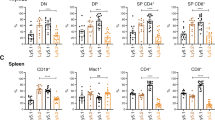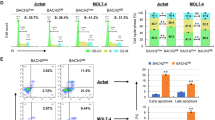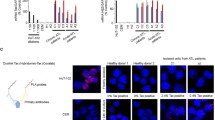Abstract
The B-cell chronic lymphocytic leukemia (CLL)/lymphoma 11B gene (BCL11B) encodes a Krüppel-like zinc-finger protein, which plays a crucial role in thymopoiesis and has been associated with hematopoietic malignancies. It was hypothesized that BCL11B may act as a tumor-suppressor gene, but its precise function has not yet been elucidated. Here, we demonstrate that the survival of human T-cell leukemia and lymphoma cell lines is critically dependent on Bcl11b. Suppression of Bcl11b by RNA interference selectively induced apoptosis in transformed T cells whereas normal mature T cells remained unaffected. The apoptosis was effected by simultaneous activation of death receptor-mediated and intrinsic apoptotic pathways, most likely as a result of tumor necrosis factor-related apoptosis-inducing ligand (TRAIL) upregulation and suppression of the Bcl-xL antiapoptotic protein. Our data indicate an antiapoptotic function of Bcl11b. The resistance of normal mature T lymphocytes to Bcl11b suppression-induced apoptosis and restricted expression pattern make it an attractive therapeutic target in T-cell malignancies.
This is a preview of subscription content, access via your institution
Access options
Subscribe to this journal
Receive 50 print issues and online access
$259.00 per year
only $5.18 per issue
Buy this article
- Purchase on Springer Link
- Instant access to full article PDF
Prices may be subject to local taxes which are calculated during checkout








Similar content being viewed by others
References
Avram D, Fields A, Pretty On Top K, Nevrivy DJ, Ishmael JE, Leid M . (2000). Isolation of a novel family of C(2)H(2) zinc finger proteins implicated in transcriptional repression mediated by chicken ovalbumin upstream promoter transcription factor (COUP-TF) orphan nuclear receptors. J Biol Chem 275: 10315–10322.
Avram D, Fields A, Senawong T, Topark-Ngarm A, Leid M . (2002). COUP-TF (chicken ovalbumin upstream promoter transcription factor)-interacting protein 1 (CTIP1) is a sequence-specific DNA binding protein. Biochem J 368: 555–563.
Bezrookove V, van Zelderen-Bhola SL, Brink A, Szuhai K, Raap AK, Barge R et al. (2004). A novel t(6;14)(q25-q27;q32) in acute myelocytic leukemia involves the BCL11B gene. Cancer Genet Cytogenet 149: 72–76.
Bradham CA, Qian T, Streetz K, Trautwein C, Brenner DA, Lemasters JJ . (1998). The mitochondrial permeability transition is required for tumor necrosis factor alpha-mediated apoptosis and cytochrome c release. Mol Cell Biol 18: 6353–6364.
Broome HE, Yu AL, Diccianni M, Camitta BM, Monia BP, Dean NM . (2002). Inhibition of Bcl-xL expression sensitizes T-cell acute lymphoblastic leukemia cells to chemotherapeutic drugs. Leuk Res 26: 311–316.
Cismasiu VB, Adamo K, Gecewicz J, Duque J, Lin Q, Avram D . (2005). BCL11B functionally associates with the NuRD complex in T lymphocytes to repress targeted promoter. Oncogene 24: 6753–6764.
Cismasiu VB, Ghanta S, Duque J, Albu D, Chen HM, Kasturi R et al. (2006). BCL11B participates in the activation of interleukin-2 gene expression in CD4+ T lymphocytes. Blood 108: 2695–2702.
Ehrlich S, Infante-Duarte C, Seeger B, Zipp F . (2003). Regulation of soluble and surface-bound TRAIL in human T cells, B cells, and monocytes. Cytokine 24: 244–253.
Gesk S, Martin-Subero JI, Harder L, Luhmann B, Schlegelberger B, Calasanz MJ et al. (2003). Molecular cytogenetic detection of chromosomal breakpoints in T-cell receptor gene loci. Leukemia 17: 738–745.
Gootenberg JE, Ruscetti FW, Mier JW, Gazdar A, Gallo RC . (1981). Human cutaneous T cell lymphoma and leukemia cell lines produce and respond to T cell growth factor. J Exp Med 154: 1403–1418.
Grillot DA, Merino R, Nunez G . (1995). Bcl-XL displays restricted distribution during T cell development and inhibits multiple forms of apoptosis but not clonal deletion in transgenic mice. J Exp Med 182: 1973–1983.
Inoue J, Kanefuji T, Okazuka K, Watanabe H, Mishima Y, Kominami R . (2006). Expression of TCRalphabeta partly rescues developmental arrest and apoptosis of alphabeta T cells in Bcl11b−/− mice. J Immunol 176: 5871–5879.
Insinga A, Minucci S, Pelicci PG . (2005). Mechanisms of selective anticancer action of histone deacetylase inhibitors. Cell Cycle 4: 741–743.
Jeremias I, Herr I, Boehler T, Debatin KM . (1998). TRAIL/Apo-2-ligand-induced apoptosis in human T cells. Eur J Immunol 28: 143–152.
Kim IK, Jung YK, Noh DY, Song YS, Choi CH, Oh BH et al. (2003). Functional screening of genes suppressing TRAIL-induced apoptosis: distinct inhibitory activities of Bcl-XL and Bcl-2. Br J Cancer 88: 910–917.
Klose R, Kemter E, Bedke T, Bittmann I, Kelsser B, Endres R et al. (2005). Expression of biologically active human TRAIL in transgenic pigs. Transplantation 80: 222–230.
Leid M, Ishmael JE, Avram D, Shepherd D, Fraulob V, Dolle P . (2004). CTIP1 and CTIP2 are differentially expressed during mouse embryogenesis. Gene Expr Patterns 4: 733–739.
MacLeod RA, Nagel S, Kaufmann M, Janssen JW, Drexler HG . (2003). Activation of HOX11L2 by juxtaposition with 3′-BCL11B in an acute lymphoblastic leukemia cell line (HPB-ALL) with t(5;14)(q35;q32.2). Genes Chromosomes Cancer 37: 84–91.
Medema JP, Scaffidi C, Krammer PH, Peter ME . (1998). Bcl-xL acts downstream of caspase-8 activation by the CD95 death-inducing signaling complex. J Biol Chem 273: 3388–3393.
Mori N, Fujii M, Cheng G, Ikeda S, Yamasaki Y, Yamada Y et al. (2001). Human T-cell leukemia virus type I tax protein induces the expression of anti-apoptotic gene Bcl-xL in human T-cells through nuclear factor-kappaB and c-AMP responsive element binding protein pathways. Virus Genes 22: 279–287.
Motoyama N, Wang F, Roth KA, Sawa H, Nakayama K, Negishi I et al. (1995). Massive cell death of immature hematopoietic cells and neurons in Bcl-x-deficient mice. Science 267: 1506–1510.
Nagel S, Kaufmann M, Drexler HG, MacLeod RA . (2003). The cardiac homeobox gene NKX2–5 is deregulated by juxtaposition with BCL11B in pediatric T-ALL cell lines via a novel t(5;14)(q35.1;q32.2). Cancer Res 63: 5329–5334.
Nebbioso A, Clarke N, Voltz E, Germain E, Ambrosino C, Bontempo P et al. (2005). Tumor-selective action of HDAC inhibitors involves TRAIL induction in acute myeloid leukemia cells. Nat Med 11: 77–84.
Oshiro A, Tagawa H, Ohshima K, Karube K, Uike N, Tashiro Y et al. (2006). Identification of subtype-specific genomic alterations in aggressive adult T-cell leukemia/lymphoma. Blood 107: 4500–4507.
Przybylski GK, Dik WA, Wanzeck J, Grabarczyk P, Majunke S, Martin-Subero JI et al. (2005). Disruption of the BCL11B gene through inv(14)(q11.2q32.31) results in the expression of BCL11B-TRDC fusion transcripts and is associated with the absence of wild-type BCL11B transcripts in T-ALL. Leukemia 19: 201–208.
Sakata J, Inoue J, Ohi H, Kosugi-Okano H, Mishima Y, Hatakeyama K et al. (2004). Involvement of V(D)J recombinase in the generation of intragenic deletions in the Rit1/Bcl11b tumor suppressor gene in gamma-ray-induced thymic lymphomas and in normal thymus of the mouse. Carcinogenesis 25: 1069–1075.
Schneider U, Schwenk HU, Bornkamm G . (1977). Characterization of EBV-genome negative ‘null’ and ‘T’ cell lines derived from children with acute lymphoblastic leukemia and leukemic transformed non-Hodgkin lymphoma. Int J Cancer 19: 621–626.
Senawong T, Peterson VJ, Avram D, Shepherd DM, Frye RA, Minucci S et al. (2003). Involvement of the histone deacetylase SIRT1 in chicken ovalbumin upstream promoter transcription factor (COUP-TF)-interacting protein 2-mediated transcriptional repression. J Biol Chem 278: 43041–43050.
Senawong T, Peterson VJ, Leid M . (2005). BCL11A-dependent recruitment of SIRT1 to a promoter template in mammalian cells results in histone deacetylation and transcriptional repression. Arch Biochem Biophys 434: 316–325.
Simon AK, Williams O, Mongkolsapaya J, Jin B, Xu XN, Walczak H et al. (2001). Tumor necrosis factor-related apoptosis-inducing ligand in T cell development: sensitivity of human thymocytes. Proc Natl Acad Sci USA 98: 5158–5163.
Sun XM, Bratton SB, Butterworth M, MacFarlane M, Cohen GM . (2002). Bcl-2 and Bcl-xL inhibit CD95-mediated apoptosis by preventing mitochondrial release of Smac/DIABLO and subsequent inactivation of X-linked inhibitor-of-apoptosis protein. J Biol Chem 277: 11345–11351.
Topark-Ngarm A, Golonzhka O, Peterson VJ, Barrett Jr B, Martinez B, Crofoot K et al. (2006). CTIP2 associates with the NuRD complex on the promoter of p57KIP2, a newly identified CTIP2 target gene. J Biol Chem 281: 32272–32283.
Wakabayashi Y, Inoue J, Takahashi Y, Matsuki A, Kosugi-Okano H, Shinbo T et al. (2003a). Homozygous deletions and point mutations of the Rit1/Bcl11b gene in gamma-ray induced mouse thymic lymphomas. Biochem Biophys Res Commun 301: 598–603.
Wakabayashi Y, Watanabe H, Inoue J, Takeda N, Sakata J, Mishima Y et al. (2003b). Bcl11b is required for differentiation and survival of alphabeta T lymphocytes. Nat Immunol 4: 533–539.
Zhang L, Fang B . (2005a). Mechanisms of resistance to TRAIL-induced apoptosis in cancer. Cancer Gene Ther 12: 228–237.
Zhang N, He YW . (2005b). The antiapoptotic protein Bcl-xL is dispensable for the development of effector and memory T lymphocytes. J Immunol 174: 6967–6973.
Acknowledgements
We thank R Jack, J Sonnemann, J Beck, J Mayerle, FU Weiss and M Lerch from the University of Greifswald for helpful discussion and critical reading of the manuscript. This work was supported by the Alfried Krupp von Bohlen and Halbach Stiftung (PG, GKP, JB and CAS), the Committee for Scientific Research, Poland (Grant KBN 2 P05A 057 26; GKP), the German Josĕ Carreras Leukemia Foundation (PG, KA and CAS) and BMBF-NBL3 (PG, CAS and UV).
Author information
Authors and Affiliations
Corresponding author
Additional information
Supplementary Information accompanies the paper on the Oncogene website (http://www.nature.com/onc).
Supplementary information
Rights and permissions
About this article
Cite this article
Grabarczyk, P., Przybylski, G., Depke, M. et al. Inhibition of BCL11B expression leads to apoptosis of malignant but not normal mature T cells. Oncogene 26, 3797–3810 (2007). https://doi.org/10.1038/sj.onc.1210152
Received:
Revised:
Accepted:
Published:
Issue Date:
DOI: https://doi.org/10.1038/sj.onc.1210152
Keywords
This article is cited by
-
Elucidating disease-associated mechanisms triggered by pollutants via the epigenetic landscape using large-scale ChIP-Seq data
Epigenetics & Chromatin (2023)
-
BCL11B Upregulates the Expression of RelA in T Cells Stimulated with Staphylococcal Enterotoxin A
Bulletin of Experimental Biology and Medicine (2022)
-
miR-214 is Stretch-Sensitive in Aortic Valve and Inhibits Aortic Valve Calcification
Annals of Biomedical Engineering (2019)
-
Functional characterization of common BCL11B gene desert variants suggests a lymphocyte-mediated association of BCL11B with aortic stiffness
European Journal of Human Genetics (2018)
-
Gga-miR-219b targeting BCL11B suppresses proliferation, migration and invasion of Marek’s disease tumor cell MSB1
Scientific Reports (2017)



